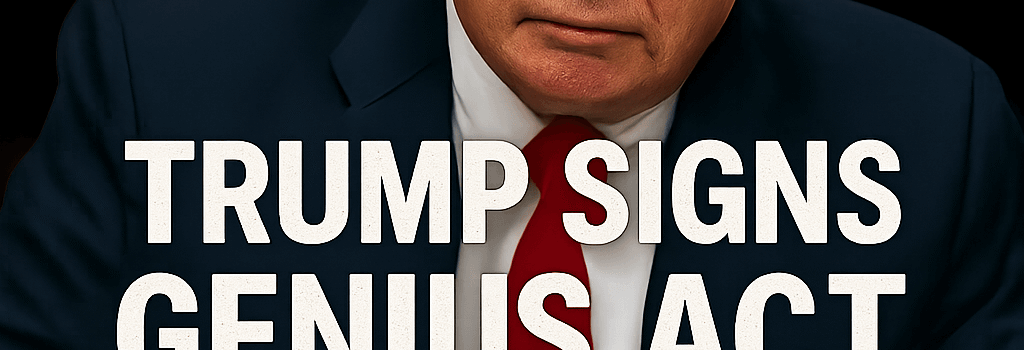Trump Signs GENIUS Act as Stablecoin Surges Amid Bribery Alerts

Donald Trump is poised to sign the GENIUS Act into law, marking the first comprehensive federal framework for stablecoins. As a self-described pro-crypto president, this move cements his administration’s stance but raises concerns about potential abuse of office and consumer risk.
Overview of the GENIUS Act
The Generating Reliable and Efficient Innovation in US Stablecoins Act or GENIUS Act passed the House by a strong bipartisan vote after clearing the Senate last month. The legislation defines stablecoins as digital tokens pegged to the US dollar or other approved low-risk assets. Key provisions include:
- Uniform federal charter for stablecoin issuers under the Commodity Exchange Act
- Mandatory 1:1 reserve backing with monthly third-party audit attestations
- Annual independent financial statements for major stablecoin issuers
- Strict collateral composition rules favoring US Treasuries and cash equivalents
Technical Architecture and Stablecoin Mechanics
Most stablecoins today follow an ERC20 standard deployed on Ethereum Layer 1 or compatible EVM chains. Issuers hold a mix of short-duration US Treasuries, commercial paper and cash equivalents in segregated trust accounts. Smart contracts enable minting and burning of tokens on demand, while reserve attestations use Merkle proofs published on-chain and cross-checked by third-party auditors.
Blockchain analyst Dr Lin Ma of the MIT Digital Currency Initiative observes that effective reserve management and decentralized oracle feeds are critical to prevent price slippage and maintain peg stability.
Consumer Protection and Risk Factors
While the act mandates monthly reserve disclosures, critics argue there is no real-time proof of solvency or stress-testing framework. Algorithmic stablecoins relying on protocol-governed buyback models remain outside the law when backed by DAOs rather than regulated entities. Potential risks include:
- Peg depegging during market stress leading to user capital flight
- Counterparty risk if reserve custodians lack sufficient capital buffers
- Operational risk from smart contract vulnerabilities and oracle failures
Global Regulatory Landscape
The US framework trails Europe’s MiCA regime, which came into force in June 2025 and requires crypto firms to hold 1:1 reserves with enhanced deposit insurance and stricter governance rules. Japan’s FSA is piloting bank-supervised stablecoin issuance, and Singapore’s MAS has adopted a risk-adjusted approach under its Payment Services Act. Diverging standards may spur regulatory arbitrage.
Political Implications and Corruption Risks
Leading Democrats such as Representative Maxine Waters warned that the GENIUS Act does not prevent presidents from owning or promoting stablecoins. Allegations have surfaced that foreign entities like Binance and UAE-linked investment vehicles plan multi-hundred-million-dollar deals with the Trump family. The Office of Government Ethics is under pressure to investigate potential conflicts.
According to former OGE director David Strong, any legislation without conflict-of-interest safeguards risks enabling foreign influence operations through digital asset channels.
Market Impact and Industry Response
Crypto markets rallied immediately after congressional approval. Ethereum gas fees remained elevated as stablecoin transaction volume spiked. Ether reached a six-month high while bitcoin topped $120,000. Firms like Circle and Paxos signaled expansion into new payment rails, and major exchanges prepared to onboard millions of new stablecoin wallets.
Implications for Traditional Banking Infrastructure
Banks face disintermediation as stablecoins offer near-instant settlement and programmable payments. The clearing gap between traditional ACH settlement windows and on-chain finality highlights the need for bank node integration. Financial institutions such as Goldman Sachs and JPMorgan are exploring hybrid ledger nodes to bridge fiat rails with public blockchains.
Future Outlook and Additional Legislation
Beyond the GENIUS Act, the House approved the CLARITY Act and an anti-CBDC bill. The CLARITY Act would shift oversight from the SEC to the CFTC, potentially retroactively legalizing past crypto practices. Analysts at Pangaea Policy predict these measures will stall in the Senate unless consumer protection groups relent.
Crypto policy analyst Terry Haines warns that without robust consumer safeguards, the stablecoin framework may sow seeds for the next financial crisis.
Conclusion
The GENIUS Act is a landmark but imperfect law. It formalizes stablecoin operations while leaving gaps in real-time solvency proof and conflict safeguards. As the US vies with other jurisdictions, the true test will be implementation by regulators and resilience of the underlying blockchain infrastructure.